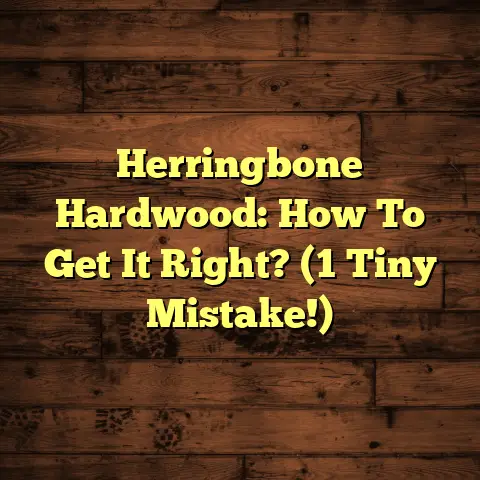Wood vs. Tile: Which Floor Wins? (1 Key Factor!)
Do you remember the warmth of your grandmother’s wooden kitchen floor, where every creak told a story?
Or perhaps the cool, glossy tiles in your childhood home that were perfect for summer afternoons?
Flooring. It’s more than just what we walk on.
It’s the foundation of our homes and memories.
As a flooring contractor with years of experience, I’ve seen trends come and go, but the wood vs.
tile debate? That’s a classic.
Today, I’m diving deep into this head-to-head, focusing on the one key factor that truly determines which floor wins: longevity.
1. The Allure of Wood Flooring
1.1 Historical Significance
Wood flooring isn’t just a modern trend; it’s been a staple in homes for centuries.
Think about it: castles, cabins, grand estates – wood has been there, adding warmth and character.
Its historical significance lies in its availability, workability, and the sheer beauty it brings to a space.
I remember working on a historic home downtown where we uncovered original hardwood floors.
They were over a hundred years old!
The craftsmanship was incredible, and it was a testament to the enduring appeal of wood.
1.2 Aesthetic Appeal
Let’s face it: wood is gorgeous.
The natural grain, the variations in color, the textures – it’s a feast for the eyes.
You’ve got options like oak, maple, cherry, walnut, each with its unique personality.
And the finish? Matte, glossy, distressed – the possibilities are endless.
I had a client recently who wanted to create a rustic, farmhouse vibe in their new home.
We went with wide-plank, hand-scraped hickory, and the result was breathtaking.
It completely transformed the space.
1.3 Comfort and Feel
There’s something inherently comforting about walking on a wood floor.
It’s warmer underfoot than tile, and it has a certain give that makes it more forgiving.
The sound of footsteps on wood? It’s music to my ears!
It creates a sense of coziness that’s hard to replicate.
I always tell my clients to consider how the floor feels as much as how it looks.
1.4 Environmental Aspects
Sustainability is a big deal these days, and rightfully so.
The good news is that wood flooring can be an eco-friendly option, if you choose responsibly sourced wood.
Look for certifications like the Forest Stewardship Council (FSC) to ensure the wood comes from well-managed forests.
Bamboo is another great option; it’s a rapidly renewable resource.
And don’t forget about reclaimed wood!
Giving old wood a new life is not only environmentally responsible but also adds character and history to your home.
2. The Practicality of Tile Flooring
2.1 Versatility and Design Options
Tile has come a long way, baby!
It’s not just your basic square anymore.
You can find tile in every shape, size, color, and pattern imaginable.
Plus, advances in technology mean you can even get tile that looks like wood or stone.
Talk about versatility!
I recently installed a porcelain tile floor that looked exactly like reclaimed barn wood.
My client was thrilled because they got the look they wanted with the durability of tile.
2.2 Durability and Maintenance
This is where tile really shines.
It’s incredibly durable, resistant to scratches, water, and stains.
That makes it a great choice for high-traffic areas, bathrooms, kitchens, and homes with pets.
Maintenance is a breeze; just sweep and mop regularly.
I’ve seen tile floors that have lasted for decades with minimal upkeep.
2.3 Temperature Regulation
Tile tends to stay cooler than wood, which can be a major plus in warm climates.
It can help regulate the temperature in your home, reducing your reliance on air conditioning.
Of course, that can also be a downside in colder climates, but you can always add rugs to warm things up.
I had a client in Arizona who swore by her tile floors.
She said they made a huge difference in keeping her house cool during the scorching summer months.
2.4 Health Considerations
Tile is a hygienic flooring option.
It’s resistant to allergens and easy to clean, which makes it a good choice for people with allergies or asthma.
Unlike carpet, tile doesn’t trap dust, pollen, or pet dander.
Plus, many tiles are antimicrobial, which means they inhibit the growth of bacteria and mold.
I always recommend tile to clients who are concerned about indoor air quality.
3. The Key Factor – Longevity
Okay, let’s get down to the nitty-gritty.
We’ve talked about aesthetics, comfort, and practicality, but what about longevity?
Which floor is going to last longer?
That’s the million-dollar question, and it’s the key factor in determining which floor wins.
3.1 Lifespan Comparison
Here’s the breakdown:
-
Hardwood: With proper care, hardwood floors can last for 100 years or more. They can be refinished multiple times, extending their lifespan.
-
Engineered Wood: Engineered wood typically lasts for 20-30 years. It can be refinished once or twice, depending on the thickness of the veneer layer.
-
Tile: Tile can last for 50-100 years or more. It’s incredibly durable, but the grout may need to be resealed periodically.
As you can see, both wood and tile can have impressive lifespans.
However, the type of wood and tile matters.
A high-quality hardwood like oak or maple will outlast a softer wood like pine.
Similarly, porcelain tile is more durable than ceramic tile.
Factors that affect longevity:
-
Wear and Tear: High-traffic areas will take a toll on any flooring.
-
Maintenance: Regular cleaning and proper care are essential for extending the life of your floors.
-
Environmental Conditions: Excessive moisture or humidity can damage wood floors.
I’ve seen hardwood floors that were ruined by water damage, and tile floors that cracked due to improper installation.
3.2 Resale Value
Longevity plays a big role in resale value.
According to a study by the National Association of Realtors, 82% of buyers said that hardwood floors increased the value of a home.
Tile can also add value, especially in bathrooms and kitchens.
However, hardwood floors tend to be more appealing to buyers overall.
I’ve seen homes sell faster and for more money simply because they had beautiful hardwood floors.
3.3 Long-term Investment
When you’re choosing flooring, you need to think long-term.
What’s the initial cost? What about maintenance costs?
How long will the floor last?
Here’s a general comparison:
| Flooring Type | Initial Cost | Maintenance Costs | Lifespan |
|---|---|---|---|
| Hardwood | Higher | Moderate | 100+ years |
| Engineered | Moderate | Moderate | 20-30 years |
| Tile | Moderate | Low | 50-100+ years |
While hardwood has a higher initial cost, its longevity and potential to increase home value can make it a worthwhile investment.
Tile is a more budget-friendly option, and its low maintenance costs make it attractive in the long run.
I had a client who was torn between hardwood and tile.
We ran the numbers, factoring in the initial cost, maintenance costs, and potential resale value.
In the end, they chose hardwood because they felt it was the best long-term investment.
4. User Experience and Preferences
4.1 Personal Anecdotes
I’ve heard countless stories from homeowners about their flooring experiences.
Some people are die-hard wood lovers, while others swear by tile.
It really comes down to personal preference.
One client told me that her hardwood floors reminded her of her childhood home and brought her a sense of comfort.
Another client said that her tile floors were perfect for her active family and made cleaning up messes a breeze.
I always encourage my clients to think about how they want their home to feel.
What kind of atmosphere do they want to create?
That will help them narrow down their flooring choices.
4.2 Trends in Flooring
Flooring trends are constantly evolving.
Right now, I’m seeing a lot of interest in wide-plank hardwood, matte finishes, and natural-looking tile.
Gray tones are also popular.
However, I always caution my clients against choosing flooring solely based on trends.
Trends come and go, but your floors are going to be around for a long time.
Choose something that you love and that will stand the test of time.
Conclusion
So, which floor wins the wood vs. tile debate?
The answer, as you might have guessed, is: it depends.
Both wood and tile have their pros and cons.
But when you’re making your decision, remember to consider the key factor: longevity.
Think about your lifestyle, your budget, and your long-term goals.
Do you want a floor that will last for generations?
Or are you more concerned with affordability and low maintenance?
Ultimately, the best floor for you is the one that meets your needs and reflects your personal style.
What type of flooring would you choose for your ideal home?





